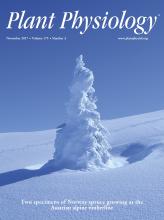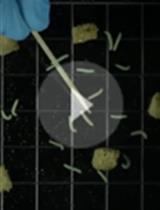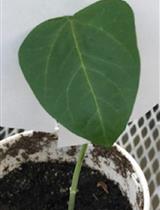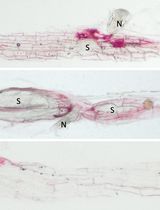- EN - English
- CN - 中文
Arabidopsis-Green Peach Aphid Interaction: Rearing the Insect, No-choice and Fecundity Assays, and Electrical Penetration Graph Technique to Study Insect Feeding Behavior
拟南芥与绿桃蚜相互作用:昆虫喂养、无选择性育性分析和昆虫刺吸电位技术在研究昆虫摄食行为中的应用
发布: 2018年08月05日第8卷第15期 DOI: 10.21769/BioProtoc.2950 浏览次数: 10343
评审: Renate WeizbauerZhao ZhangAnonymous reviewer(s)
Abstract
Aphids constitute a large group of Hemipterans that use their slender stylets to tap into the sieve elements of plants from which they consume copious amounts of phloem sap, thus depriving the plant of photoassimilates. Some aphids also transmit viral diseases of plants. Myzus persicae Sülzer, commonly known as the green peach aphid (GPA), which is a polyphagous insect with a host range that covers 50 plant families, is considered amongst the top 3 insect pest of plants. The interaction between Arabidopsis thaliana and the GPA is utilized as a model pathosystem to study plant-aphid interaction. Here we describe the protocol used in our laboratories for rearing the GPA, and no-choice and fecundity bioassays to study GPA performance on Arabidopsis. In addition, we describe the procedure for the electrical penetration graph (EPG) technique to monitor feeding behavior of the GPA on Arabidopsis.
Keywords: Myzus persicae (绿桃蚜)Background
Aphids are important pests of plants that utilize their mouthparts, which are modified into stylets, to remove phloem sap from the sieve elements. As part of their feeding process, aphids deposit saliva into the plant tissue. While some salivary components elicit plant defenses, others manipulate host physiology to benefit the insect, including suppressing plant defenses (Nalam et al., 2018). Plants utilize a variety of defenses to control aphid infestation. These include antibiosis, which adversely impacts aphid growth, development and fecundity, and antixenosis, which affects insect behavior, including feeding behavior. These defenses are exerted at various steps, including at the cell surface, during the intercellular penetration of leaf tissue by the insect stylet, when the stylet tip is inside plant cells, and when the stylet tip is in the sieve elements (Nalam et al., 2018). The green peach aphid (GPA), Myzus persicae Sülzer, is an important pest of plants in numerous families, including the Brassicaceae, Solanaceae, Cucurbitaceae, Rosaceae, Asteraceae, Malvaceae, Amaranthaceae (Blackman and Eastop, 2000). In addition, the GPA transmits several viral diseases (Kennedy et al., 1963; Matthews, 1991). During the last decade, the interaction between Arabidopsis thaliana, which belongs to the Brassicaceae family, and the GPA has been increasingly utilized to study plant-aphid interaction (Louis et al., 2012; Louis and Shah, 2013). This pathosystem has facilitated understanding of the physiological and molecular processes that determine the outcome of plant-aphid interaction, including plant defense mechanisms and their impact on insect population growth, fecundity and behavior (Louis et al. 2012; Louis and Shah, 2013).
The direct current (DC)-electrical penetration graph (EPG) system, which measures the electromotive force (EMF) signal and fluctuations in electrical resistance resulting from aphid stylet penetrations, provides a sensitive method to monitor aphid feeding behavior on plants (Tjallingii, 1985; Salvador-Recatalà and Tjallingii, 2015). When the aphid stylet is inserted intercellularly, the voltage is positive and when inserted intracellularly, the voltage is negative (Tjallingii, 2006). The different EPG waveform patterns are indicative of the different activities in which the insect is engaged. Moreover, the duration of each type of waveform provides a quantitative measure of the effect of plant genotype and/or treatment on insect feeding behavior, including the time spent by the insect feeding from the sieve elements. However, despite the success of the Arabidopsis-GPA pathosystem, the protocols utilized to study aphid population growth, fecundity and feeding behavior have not been described in detail. Here, we detail the protocols for rearing a Brassicaceae-adapted colony of the GPA, no-choice assays for monitoring GPA population growth, fecundity assays to monitor insect reproductive rate, and the EPG analysis to monitor GPA feeding behavior on Arabidopsis.
Part I: Rearing the green peach aphid
The green peach aphid (Myzus persicae) colony is maintained on a mix of radish (Raphanus sativus ‘Early Scarlet Globe’) and mustard (Brassica juncea ‘Florida Broadleaf’) plants, which like Arabidopsis belong to the Brassicaceae family. On Brassicaceae, GPA reproduces asexually by releasing live apterous (wingless) nymphs.
Materials and Reagents
- T.O. Plastics Standard Flats 1020 tray with bottom holes (Hummert International, model: STE-1020-OPEN - WITH HOLES, catalog number: 11-3000-1 )
- T.O. Plastics Standard Flats 1020 tray without holes (Hummert International, model: STE-1020-NH - NO HOLES, catalog number: 11-3050-1 )
- Square injection molded plastic pots (4.5” [11.43 cm] width x 3.75” [9.53 cm] height) with holes at the bottom (International Greenhouse, catalog number: CN-SQK )
- Twist ties
- Biohazard autoclave bags (Fisher Scientific, catalog number: 01-830D )
- NalgeneTM polypropylene heavy duty sterilizing tray (Thermo Fisher Scientific, catalog number: 6900-0020 )
- Soil Mix (Sunshine® Mix #8, Sun Gro Horticulture, model: Fafard®-2 )
- Radish seeds (Radish Early Scarlet Globe) (Main Street Seed & Supply, catalog number: 13307-13 )
- Mustard seeds (Florida Mustard Broad Leaf) (Main Street Seed & Supply, catalog number: 12501-13 )
- Green peach aphid colony (Specimen number 194 deposited with Kansas State University Museum of Entomological and Prairie Arthropod Research)
Equipment
- Plant growth chamber (Percival Scientific, model: AR-66L2 )
Note: Programmed for a 14/10 h day (80-100 μE m-2 sec-1)/night photoperiod at 22 °C. - Autoclave
Procedure
文章信息
版权信息
© 2018 The Authors; exclusive licensee Bio-protocol LLC.
如何引用
Nalam, V., Louis, J., Patel, M. and Shah, J. (2018). Arabidopsis-Green Peach Aphid Interaction: Rearing the Insect, No-choice and Fecundity Assays, and Electrical Penetration Graph Technique to Study Insect Feeding Behavior. Bio-protocol 8(15): e2950. DOI: 10.21769/BioProtoc.2950.
分类
植物科学 > 植物免疫 > 植物-昆虫互作
您对这篇实验方法有问题吗?
在此处发布您的问题,我们将邀请本文作者来回答。同时,我们会将您的问题发布到Bio-protocol Exchange,以便寻求社区成员的帮助。
Share
Bluesky
X
Copy link















